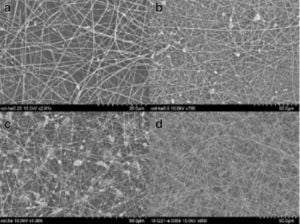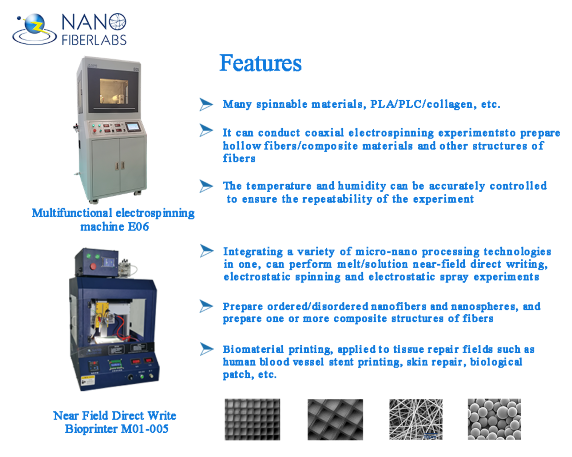Copyright © 2022 Foshan MBRT Nanofiberlabs Technology Co., Ltd All rights reserved.Site Map
Collagen is the main fibrin in the extracellular matrix, which accounts for 20%-30% of the human body and is rich in content. Collagen is very flexible and can be used in the field of biological tissue engineering after being modified or compounded into various forms. It has significant effects in regulating cell functions and providing structural support for tissues and organs. Electrospinning is a simple and easy-to-use fiber preparation method, which can prepare fibers with diameters from a few microns to a few nanometers, and can spin more than 200 kinds of polymers. Collagen is often used as a material for electrospinning. At present, electrospinning can prepare collagen nanofibers with a variety of aligned and random structures, which is suitable for a variety of ways. In tissue engineering, the arrangement of fibers will affect cell activity and mechanical properties.
Electrospinning technology transforms collagen material into nanofibers, which present porous micro-nano structures, with good mechanical properties and excellent biocompatibility. The potential uses of these nanofibers in biomedical applications include tissue engineering (such as skin tissue regeneration, artificial blood vessel scaffolds, cartilage repair, etc.). Clinical medicine field (including drug delivery, hemostatic dressing, periodontal repair, biofilm and wound dressing, etc.). The following figure illustrates the similarity between electrospinning collagen fibers and extracellular matrix and the related applications after modification.

Figure 1 The extracellular matrix-like structure of electrospinning collagen fibers and the application of modified fibers in tissue engineering
Collagen nanofibers are superior to other polymer nanofibers in several aspects. First, collagen is the main ECM protein in many tissues in the body. Therefore, collagen nanofibers are the fibers closest to the microstructure of natural tissues. Secondly, the immunogenicity of collagen is poor. The implantation of collagen nanofibers is unlikely to activate the host immune response. Third, collagen has excellent biocompatibility. Therefore, the collagen nanofiber scaffold is suitable for most body tissues. But the most obvious disadvantage of collagen nanofibers is poor mechanical properties. The mechanical properties of collagen nanofibers can be cross-linked or modified with natural/synthetic polymers or inorganic molecules to enhance their mechanical properties.

Figure 2 Collagen solution containing unmodified n-HA (a) 3.8 wt%, (b) 4.4 wt%, (c) 5.0 wt% and (d) 4.4 wt% L-electrospinning collagen nanofiber scaffolds Microscopic picture of glutamate grafted nHA
Because the structure is similar to natural tissues, electrospinning collagen can also fuse with natural tissues to form a cell layer. From the structural point of view, it is very suitable for regeneration and reconstruction of injured skin. The three-dimensional microstructure prepared from the composite material of electrospinning collagen can be used to effectively stimulate tissue regeneration. The network structure of these materials helps promote the integration and recruitment of new tissues to their fibrous scaffolds, thereby accelerating the growth of new tissues. In the treatment of skin wounds, these materials can be used to prepare dressings that keep the wound moist and prevent bacterial infections, and the composite materials produced can effectively reduce contact with the outside world from the influence of air. The main function of nanofiber scaffolds is to provide a suitable three-dimensional environment for cells to adhere and proliferate.
Nanofiberlabs focuses on the field of electrospinning. We can provide scientific and educational electrospinning equipment, electrospinning pilot equipment, and nanofiber industrialization equipment. Our equipment is sold to many countries around the world, with mature technical support. The multifunctional electrospinning machine E06 is fully functional, equipped with a temperature and humidity control system, and can realize coaxial electrospinning experiments. The bioprinter M01-005 using near-field direct writing technology can prepare biological materials for tissue repair, and can replace the solution/melt/electrospinning/electrostatic spray module for work.

E06 Device link: https://www.nanofiberlabs.com/product/multifunctional-electrospinning-machine-e06.html
M01-005 Device link: https://www.nanofiberlabs.com/product/desktop-nano-material-processing-center-3d-printer-for-biomaterials-m01-005.html
References
[1] Law JX, Liau LL, Saim A, Yang Y, Idrus R. Electrospun Collagen Nanofibers and Their Applications in Skin Tissue Engineering. Tissue Eng Regen Med. 2017;14(6):699-718. Published 2017 Aug 10. Doi:10.1007/s13770-017-0075-9
[2] Lu W P, Guo Y. Electrospinning of collagen and its derivatives for biomedical applications[J]. Novel Aspects of Nanofibers, 2018: 39. Doi:10.5772/intechopen.73581
[3] Jha B S, Ayres C E, Bowman J R, et al. Electrospun collagen: a tissue engineering scaffold with unique functional properties in a wide variety of applications[J]. Journal of Nanomaterials, 2011, 2011. doi:10.1155/2011/348268
[4] Kwon G W, Gupta K C, Jung K H, et al. Lamination of microfibrous PLGA fabric by electrospinning a layer of collagen-hydroxyapatite composite nanofibers for bone tissue engineering[J]. Biomaterials research, 2017, 21(1): 1-12. Doi:10.1186/s40824-017-0097-3.
[5] Nemati S, Kim S, Shin Y M, et al. Current progress in application of polymeric nanofibers to tissue engineering[J]. Nano convergence, 2019, 6(1): 1-16. Doi: 10.1186/s40580-019-0209-y